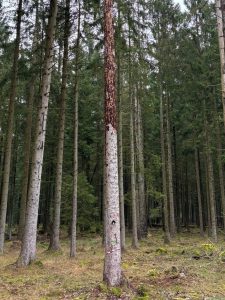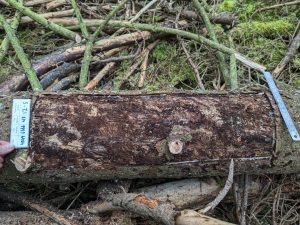Summary
Ips typographus, the eight-toothed spruce bark beetle, is the most serious and destructive pest of spruce trees (Picea spp.) in Europe. The impacts of Ips typographus on Norway spruce (Picea abies) have been well studied, but little is known about the suitability of Sitka spruce (Picea sitchensis) as a host for the beetle, or how resistant it is to attack, because it is rarely planted in continental Europe. In Britain, however, Sitka spruce is the most extensively planted tree species and the most economically important conifer. Thus, it is critical to understand the threat that I. typographus poses to Sitka spruce.

This Norway spruce (pictured above) is one of our experimental trees in a plantation in Denmark, in a forest stand where Norway and Sitka spruce grow side-by-side. Both Sitka and Norway spruce trees were baited with a pheromone attractive to Ips typographus, and colonisation success will be compared between the two species. The bark panel (pictured below) shows extensive colonisation by Ips typographus, which has killed the tree.

Research Objectives
Findings by our research group to date indicate that cut logs of Sitka spruce are suitable for colonisation by Ips typographus. However, cut logs will have significantly altered defensive capabilities compared with intact live trees. We are currently investigating the susceptibility of live, European-grown Sitka spruce trees to attack from I. typographus. To do this, we aim to answer the following research questions:
- How is the susceptibility of Sitka spruce influenced by drought stress and wind-throw, the two primary drivers of Ips typographus population growth and outbreak, at the level of both forest stand and individual tree?
- Do the induced defences (specifically traumatic resin ducts) of Sitka spruce differ in magnitude and rate of formation to those of Norway spruce when challenged by bark beetle attack?
- Do chemical defences and rate of build-up differ between Sitka and Norway spruce when challenged with bark beetle attack?
- How does the population size of Ips typographus vary between Norway spruce and Sitka spruce forest stands under endemic, non-outbreak conditions?
Related research
Larger eight-toothed European spruce bark beetle (Ips typographus) – Forest Research
Evidence of cross-channel dispersal into England of the forest pest Ips typographus
Funding & Partners
-
 DEFRA
DEFRA -
 University of Copenhagen
University of Copenhagen
